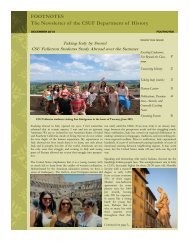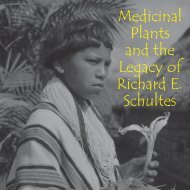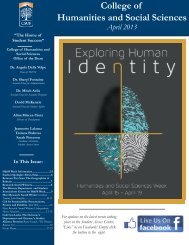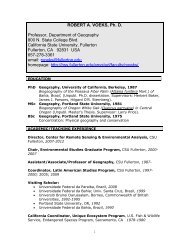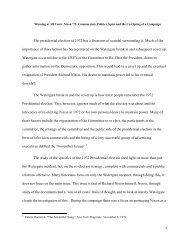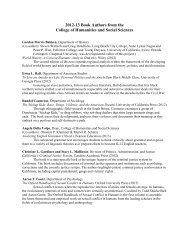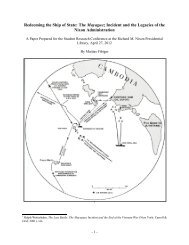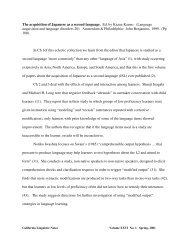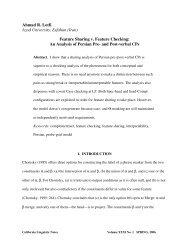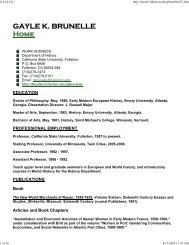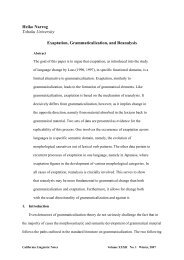1 Steven R. James Brief Biographical Sketch - College of ...
1 Steven R. James Brief Biographical Sketch - College of ...
1 Steven R. James Brief Biographical Sketch - College of ...
You also want an ePaper? Increase the reach of your titles
YUMPU automatically turns print PDFs into web optimized ePapers that Google loves.
Pr<strong>of</strong>essional Preparation<strong>Steven</strong> R. <strong>James</strong><strong>Brief</strong> <strong>Biographical</strong> <strong>Sketch</strong>(Prepared for Environmental Studies Program 12-2007)University <strong>of</strong> California, Berkeley Anthropology B.A. 1975University <strong>of</strong> Utah Anthropology M.A. 1982Arizona State University Anthropology Ph.D. 1994Appointments (Recent Years)2006-present2006-presentAssociate Pr<strong>of</strong>essor <strong>of</strong> Anthropology, Department <strong>of</strong> Anthropology,California State University, Fullerton, CA.Director, Archaeological Research Facility, Department <strong>of</strong> Anthropology,California State University, Fullerton, CA.2003-2006 Assistant Pr<strong>of</strong>essor <strong>of</strong> Anthropology, Department <strong>of</strong> Anthropology,California State University, Fullerton, CA.2000-2003 Associate State Archaeologist, Cultural Resources Division, CaliforniaDepartment <strong>of</strong> Parks and Recreation, Sacramento, CA (HeadquartersOffice).1995-2000 Project Director and Senior Research Analyst, Cultural ResourcesManagement Program, Gila River Indian Community, Sacaton, AZ.1994-2003 Adjunct Pr<strong>of</strong>essor <strong>of</strong> Anthropology, Department <strong>of</strong> Anthropology, ArizonaState University, Tempe, AZ.1993-1994 Faculty Member in Anthropology, Social Sciences Department, GlendaleCommunity <strong>College</strong>, AZ.Service on Environmental Studies M.S. theses and projects2005-2007 Committee member on Jay Litvak’s thesis (with Bob Voeks [chair] and Mike Horn)2006-2007 Advisor on Ryan Cordero’s project2007-2008 Advisor on Matt Hon’s projectOther Background InformationAs part <strong>of</strong> the anthropology and archaeology courses that I teach in the AnthropologyDepartment, I have taught archaeological survey and excavation techniques to undergraduateand graduate anthropology students (and a few Environmental Studies graduate students) atCal State Fullerton (Anthropology 403, five fall semesters, 2003-2007). Fieldwork in the classhas involved a cultural resources survey <strong>of</strong> a new California state park near Yucaipa in SanBernardino County (2003), three seasons <strong>of</strong> test excavations at archaeological sites on SanNicolas Island (a Navy missile test base) in the southern Channel Islands (2004-2006), andmost recently an archaeological survey (Abalone Cove) <strong>of</strong> a portion <strong>of</strong> the land managed by thePalos Verdes Peninsula Land Conservancy in Los Angeles County (fall 2007). In addition to the1
fall field class, I have been conducting a field school (Anthropology 476, four summer sessions,2004-2007) in northern Arizona near Sedona at a major prehistoric pueblo cliff dwelling,Honanki Ruins, which dates from A.D. 1100 to 1300. This project is a joint effort with theCoconino National Forest archaeologist in Flagstaff and the Sedona Ranger District.Aside from students learning field techniques in the fall field class, the San NicolasIsland archaeological project has provided a number <strong>of</strong> opportunities for undergraduate andgraduate students at Cal State Fullerton to be involved in this research. The research potential<strong>of</strong> the San Nicolas Island project and educational experiences for students include analyzingprehistoric materials for their class projects (Anthropology 404 taught in spring semester),developing master theses on this research (prehistoric marine mammals, fishes, andinvertebrates), and enabling them to present papers on the results <strong>of</strong> their research atpr<strong>of</strong>essional meetings (e.g., Southern California Academy <strong>of</strong> Sciences, Society for CaliforniaArchaeology, etc.).I have been a member <strong>of</strong> the Nature Conservancy and other conservation organizations(e.g., Archaeology Conservancy, Sierra Club) for a number <strong>of</strong> years. I also served as anAssociate State Parks Archaeologist for California State Parks (2000-2003) at the State ParksHeadquarters Office in the Resources Building in Sacramento, and among a variety duties that Iconducted, I was involved in reviewing land acquisitions for new state parks that were to bepurchased with Park Bond funds. Before my position at State Parks, I served as a tribalarchaeologist (1995-2000) with the Gila River Indian Community, which is located just south <strong>of</strong>the Phoenix metropolitan area in southern Arizona. This cultural resource management tribalprogram was funded as part <strong>of</strong> a large irrigation water project by the Bureau <strong>of</strong> Reclamation,Arizona Projects Office. I have also lived and worked as an archaeologist in other areas <strong>of</strong> theWest and Southwest, including northern California, the Great Basin (Nevada and Utah), NewMexico, Texas, and Hawaii. From my interests and experience, I have attempted to instill in mystudents a conservation ethic for the preservation <strong>of</strong> both natural and cultural resources.Recent Refereed PublicationsIn prep Prehistoric Human Impacts on Marine and Terrestrial Mammals, Fish, and Shellfish:Examples from the American Southwest and the Channel Islands <strong>of</strong> Southern California.Chapter prepared for Archaeology <strong>of</strong> Anthropogenic Environments, edited by RebeccaM. Dean. Occasional Paper Series, Center for Archaeological Investigations, SouthernIllinois University, Carbondale (in prep. 2008)2007 Late Prehistoric Human Impacts on Marine Fauna in Southern California: An Examplefrom San Nicolas Island in the Southern Channel Islands. Bulletin <strong>of</strong> the SouthernCalifornia Academy <strong>of</strong> Sciences 106(2):97.2006 Southwest Animals. In Handbook <strong>of</strong> North American Indians, Vol. 3: Environment,Origins, and Population, edited by Douglas Ubelaker and others, pp. 313-330.Smithsonian Institution, Washington, D.C.2005 Archae<strong>of</strong>aunal Research at Late Holocene Prehistoric Sites on San Nicolas Island:Recent Excavations and Experimental Studies. Bulletin <strong>of</strong> the Southern CaliforniaAcademy <strong>of</strong> Sciences 104(2, Supplement):27 (with J. Wallace).2004 The Archaeology <strong>of</strong> Global Change: The Impact <strong>of</strong> Humans on Their Environment.Smithsonian Books, Washington, D.C. 292 pp. (co-edited with C. L. Redman, P. R.Fish, and J. D. Rogers).2
2004 Dogs, Deer, or Guanacos: Zoomorphic Figurines from Pueblo Grande, Central Arizona.Journal <strong>of</strong> Field Archaeology 29(1 & 2):165-176. Published by Boston University,Boston, MA. (with M. S. Foster).2004 The Ecology <strong>of</strong> Human Colonization in Pristine Landscapes. In The Settlement <strong>of</strong> theAmerican Continents: A Multidisciplinary Approach to Human Biogeography, edited byC. M. Barton, G. A. Clark, D. R. Yesner, and G. A. Pearson, pp. 138-161. University <strong>of</strong>Arizona Press, Tucson (with C. M. Barton and S. Schmick).2004 Part I: Habitat Transformations and Animal Extinctions. In The Archaeology <strong>of</strong> GlobalChange: The Impact <strong>of</strong> Humans on Their Environment, edited by C. L. Redman, S. R.<strong>James</strong>, P. R. Fish, and J. D. Rogers, pp. 9-12. Smithsonian Books, Washington, D.C.2004 Hunting, Fishing, and Resource Depression: Prehistoric Cultural Impacts on Animals inSouthwest North America. In The Archaeology <strong>of</strong> Global Change: The Impact <strong>of</strong>Humans on Their Environment, edited by C. L. Redman, S. R. <strong>James</strong>, P. R. Fish, and J.D. Rogers, pp. 28-62. Smithsonian Books, Washington, D.C.2004 Introduction: Human Impacts on Past Environments. In The Archaeology <strong>of</strong> GlobalChange: The Impact <strong>of</strong> Humans on Their Environment, edited by C. L. Redman, S. R.<strong>James</strong>, P. R. Fish, and J. D. Rogers, pp. 1-8. Smithsonian Books, Washington, D.C.(with C. L. Redman, P. R. Fish, and J. D. Rogers).2004 Mineral Hill Cave Avifauna. In Paleontological Investigations at Mineral Hill Cave, editedby B. Hockett and E. Dillingham, pp. 136-142. Contribution to the Study <strong>of</strong> CulturalResources No. 18. Bureau <strong>of</strong> Land Management, Reno.2004 Fishing and Marine Mammal Hunting Patterns from a 2500-Year Old Campsite on SanNicolas Island. Bulletin <strong>of</strong> the Southern California Academy <strong>of</strong> Sciences 103(2,Supplement):58-59.2003 Hunting and Fishing Patterns Leading to Resource Depletion. In Centuries <strong>of</strong> Declineduring the Hohokam Classic Period at Pueblo Grande, edited by David Abbott, pp. 70-81. University <strong>of</strong> Arizona Press, Tucson.3



